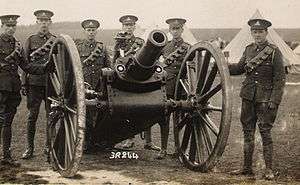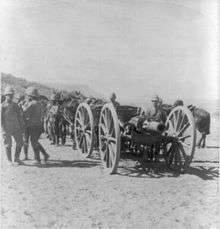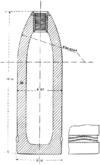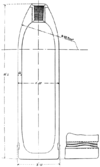BL 5-inch howitzer
| Ordnance BL 5-inch howitzer | |
|---|---|
 Territorial Force gunners with howitzer in camp pre-WWI | |
| Type | Field howitzer |
| Place of origin | United Kingdom |
| Service history | |
| In service | 1895 – 1919 |
| Used by | British Empire |
| Wars |
Mahdist War Second Boer War First World War |
| Specifications | |
| Weight | 2,672 lb (1,212 kg)[1] |
| Barrel length | 42 inches (1.07 m) bore (8.4 calibres)[2] |
|
| |
| Shell |
50 lb (22.7 kg) Common shell 50 lb (22.7 kg) Lyddite shell 40 lb (18.1 kg) Amatol shell[3] |
| Calibre | 5-inch (127.0 mm) |
| Breech | 3-motion, interrupted screw[4] |
| Recoil | 5.5 in (140 mm), Hydro-spring constant[4] |
| Carriage | Wheeled, box trail |
| Elevation | -5° - 45°[4] |
| Muzzle velocity | 788 ft/s (240 m/s)[5] |
| Effective firing range |
4,800 yards (4,400 m) (50 lb shell); 6,500 yards (5,900 m) (40 lb shell) |
| Filling weight |
9 pounds 15 ounces (4.51 kg) (Lyddite) 5 pounds (2.27 kg) (Amatol) |
The Ordnance BL 5-inch howitzer was initially introduced to provide the Royal Field Artillery with continuing explosive shell capability following the decision to concentrate on shrapnel for field guns in the 1890s.
Combat service
Sudan Campaign
The weapon was used by the Royal Field Artillery and served successfully at the Battle of Omdurman in 1898. During that campaign they gained the distinction of being the first British guns to fire the new Lyddite shells in action.
Second Boer War

Major D Hall states that in the Second Boer War the Lyddite shells often failed to detonate; the gun was too heavy to be used as a field howitzer, and for siege use its range was too short and shell too light. However, it achieved some success in Natal when able to get close enough to bombard Boers in trenches.[6]
World War I

By 1908 it was obsolete and replaced in British Regular Army brigades by the modern QF 4.5-inch howitzer.
Territorial Force brigades, however, continued to use the howitzer in World War I into 1916, including notably in the East African campaign.
A lighter 40-pound (18.14 kg) shell with Amatol filling replaced the original 50-pound (22.68 kg) Lyddite shell early in World War I Together with an increase in cordite propellant from 11 oz 7 drams to 14 oz 5 drams, this increased the maximum range from 4,800 to 6,500 yards (5,900 m). Administrative error led to the new 40-pound shells being sent to Gallipoli without range tables or fuze keys for the new pattern fuzes, rendering them useless.[7]
Ammunition
 |
 |
 |
 |
See also
Notes and references
- ↑ Hogg, Ian. Twentieth-Century Artillery. New York: Barnes & Noble Books, 2000. ISBN 0-7607-1994-2 Pg.46
- ↑ Text Book of Gunnery 1902, Table XII page 336
- ↑ Treatise on Ammunition 1915, accurate as at 1 August 1914, mentions that there are both "Heavy" 50 lb (23 kg) and "Light" 40 lb (18.1 kg) shells and mentions a 14 oz 13 dram cartridge for a 40 lb (18.1 kg) shell (page 142). But only 50 lb (22.7 kg) shells are listed in tables. It is possible the 40 lb (18.1 kg) shell was in process of being introduced in 1914.
- 1 2 3 Hogg & Thurston 1972, page 113
- ↑ Hogg & Thurston 1972 page113. Text Book of Gunnery 1902 gives 782 ft/s (238 m/s), firing a 50 pounds (22.7 kg) projectile, with 11oz 7dram Cordite size 3¾ propellant.
- ↑ Hall June 1971
- ↑ Simpson-Baikie 1920
Bibliography
- Text Book of Gunnery, 1902. LONDON : PRINTED FOR HIS MAJESTY'S STATIONERY OFFICE, BY HARRISON AND SONS, ST. MARTIN'S LANE
- Dale Clarke, British Artillery 1914-1919. Field Army Artillery. Osprey Publishing, Oxford UK, 2004 ISBN 1-84176-688-7
- Major Darrell D. Hall, "Guns in South Africa 1899-1902" in The South African Military History Society. Military History Journal - Vol 2 No 1, June 1971
- I.V. Hogg & L.F. Thurston, British Artillery Weapons & Ammunition 1914-1918. London: Ian Allan, 1972
- Brigadier-General Sir Hugh Simpson-Baikie, Ex-Commander of the British artillery at Cape Helles. Appendix I STATEMENT ON ARTILLERY in General Sir Ian Hamilton, G.C.B. Gallipoli Diary Vol. II. New York: George H. Doran Company, 1920
- Hogg, Ian. Twentieth-Century Artillery. New York: Barnes & Noble Books, 2000. ISBN 0-7607-1994-2 Pg.46
Surviving examples
- At Karak Castle, Jordan
External links
| Wikimedia Commons has media related to BL 5 inch Howitzer. |
- Handbook for the 5-inch B.L. howitzer 1905 Hosted online by State Library of Victoria, Australia
- Field service manual Field artillery howitzer brigade 5-inch B.L. 1908 Hosted online by State Library of Victoria, Australia
- Handbook for the 5-inch B.L. howitzer, 1909 Hosted online by State Library of Victoria, Australia
- Handbook and equipment details for the 5-inch B.L. howitzer Mark I field batteries 1896,1901 Hosted online by State Library of Victoria, Australia
- 5 inch B.L. howitzer gun drill 1915 Hosted online by State Library of Victoria, Australia
- Great War Diary - German East Africa 1916 - of Sergeant Joseph Daniel Fewster, 1st. (Hull) Heavy Battery R.G.A.
- Bennet Burleigh, Khartoum Campaign, 1898 Describes 5-inch howitzer use in the campaign